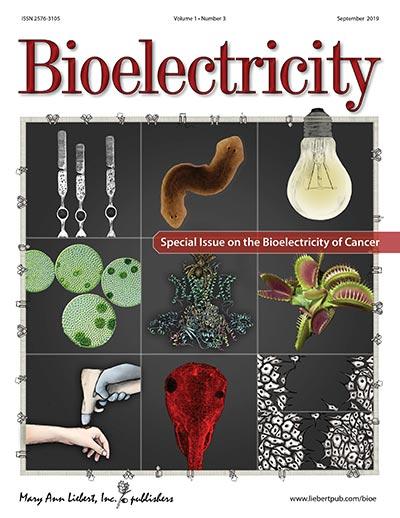
Credit: Mary Ann Liebert, Inc., publishers
New Rochelle, NY, October 8, 2019–Bioelectricity of Cancer, a special issue of the peer-reviewed journal Bioelectricity, has just been published. Two promising discoveries are well delineated: an ultra-sensitive tool to detect cancer and a new therapeutic target for cancer immunotherapy. Both papers can be viewed for free on the Bioelectricity website through November 8, 2019. Bioelectricity, published by Mary Ann Liebert, Inc., is also published in print to accommodate reader preferences.
In the article entitled “Ultrasensitive System for Electrophysiology of Cancer Cell Populations: A Review” coauthors Paulo Rocha, Aya Elghajiji, and David Tosh, University of Bath, U.K., describe the need for more sensitive electrophysiology tools to study cancer cell populations that typically produce very low levels of bioelectricity.
Rocha et al. designed an ultra-sensitive bidirectional platform that allows electrical recordings of cell populations over time, making it possible to measure changes that occur with the addition of pharmacological compounds. The system comprises a glass sensor on which are mounted two parallel, circular gold electrodes, one acting as the measuring electrode, the other as the counter-electrode. Background noise is minimized by combining these low impedance large area electrodes. The authors demonstrate the use of this system by detecting cancer cell-cell communication in rat glioma cells and in human prostate cancer cells. This new approach brings electrical detection (and treatment) of cancer closer. This is an exciting prospect since such bioelectric signals occur very early in the cancer process and bioelectric therapies would be expected to be “non-toxic” unlike, say, chemotherapy.
Also of interest is “Extracellular K+ Dampens T-Cell Functions: Implications for Immune Suppression in the Tumor Microenvironment,” by Navin Kumar Verma of the Lee Kong Chian School of Medicine, Nanyang Technological University, Singapore, with colleagues from the Agency for Science Technology and Research (Singapore), and University of California, Davis. This paper is concerned with ionic events in the tumor microenvironment (TME). The researchers show that a rise in the level of potassium ions (K+) in TME, due to release from dying tumor cells, could be exploited as a valuable therapeutic target that could boost the effectiveness of T-cell-based immunotherapy. This study demonstrated that the high K+, taken up by the anti-tumor T-cells (lymphocytes), significantly inhibited their proliferation as well as their production of cytokines whilst up-regulating the expression of the immune checkpoint protein PD-1. The authors then screened a library of compounds and identified a novel activator of a particular K+ channel (activated by calcium) in T-cells. Application of this activator (SKA-346) rescued the T-cells from the suppressive effect of the high level of K+ in TME. Thus, this bioelectric phenomenon identified a “secondary” checkpoint in cancer. Accordingly, compounds like SKA-346 can be used alongside known PD-1 inhibitors and other cancer therapeutics to improve treatment and patient outcomes. Immunotherapy frequently suffers from side effects, including adverse effects on cognitive function, so reducing its dosage by synergizing it with ion channel modulators would be welcome.
“These two articles, indeed all of the articles in this special issue, make evident the extraordinary power of looking at cancer from a bioelectrical perspective,” says Dany Spencer Adams, Editor-in-Chief of Bioelectricity. “Bioelectricity is fundamental to life – no bioelectricity, no life. It should not be surprising that monitoring bioelectricity yields valuable information about a wide range of disease states. This issue demonstrates how monitoring that mis-regulation leads to valuable clues about why cancer cells behave so badly and what we can do about it. This collection also provides a template for how to look at other diseases. I am very grateful to Drs. Djamgoz and Arcangeli for this special issue.”
###
About the Journal
Bioelectricity is the only peer-reviewed journal dedicated to the study of the natural electricity within living organisms and how to harness this phenomenon to treat and cure disease. Led by Editor-in-Chief Dany Spencer Adams, Visiting Scientist, Tufts University, Co-Founder & Chief Science Officer, Ion Diagnostics LLC, and Program Manager, Life Sciences, Akita Innovations LLC., the Journal publishes groundbreaking multidisciplinary research and advances documenting this next step in the evolution of how we study life. For complete tables of content and a sample issue, please visit the Bioelectricity website.
About the Publisher
Mary Ann Liebert, Inc., publishers is a privately held, fully integrated media company known for establishing authoritative peer-reviewed journals in many promising areas of science and biomedical research, including Stem Cells and Development, Tissue Engineering, and The CRISPR Journal.Its biotechnology trade magazine, GEN (Genetic Engineering & Biotechnology News), was the first in its field and is today the industry’s most widely read publication worldwide. A complete list of the firm’s 90 journals, newsmagazines, and books is available on the Mary Ann Liebert, Inc., publishers website.
Media Contact
Kathryn Ryan
[email protected]
914-740-2250
Original Source
https:/




